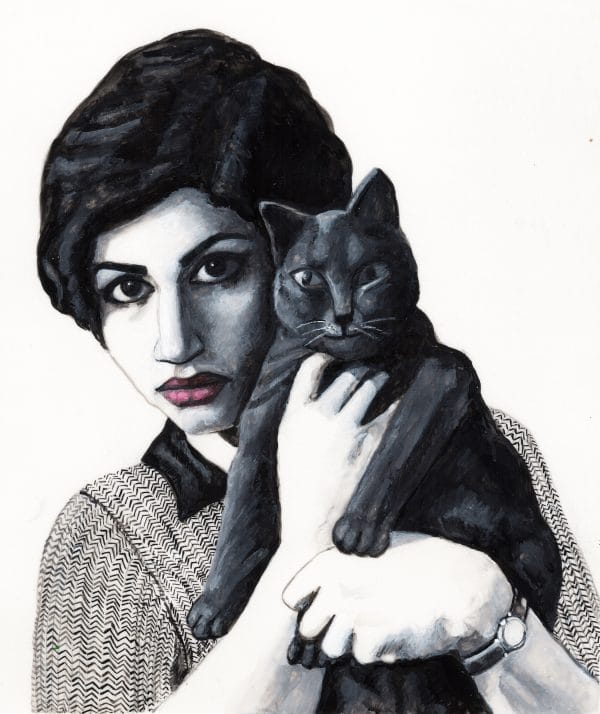Women, Life, Art: reflections on creativity, divine femininity and revolution

By Artemis Apergi, BA Persian and International Relations
On the evening of the 9 February, I helped host an event entitled ‘Women, Life, Art: In Conversation with Hayden Changizian and Soheila Sokhanvari’. These Iranian female artists were guests at a roundtable discussion chaired by SOAS PhD candidate and research assistant Katayoun Shahandeh, aimed at highlighting a primordial tie between female artists and their rebelliousness. These women made it clear to me that creativity is a boldly revolutionary act. The infusion of their artwork with an ever-present feminine divinity allows their revolution to transcend the shackles of their political and social oppression and transforms them into timeless pillars of monumental history.
I was initially inspired to write on this subject of female creativity and revolution when I read I am Imbolc, the Dream of Awakening, by Caroline Mellor for the first time. One line in this poem reads, ‘I am hope, potential, rebirth and promise. I am the kindling breath which transforms the flicker of inspiration in your creative core into a blazing torch.’ This poem succeeds in conjuring a ‘dream of awakening’, which weaves together elements of personal consciousness and the seasonal awakening of nature (Imbolc is a traditional Gaelic festival celebrating the coming of spring). The language of ‘promise’, ‘fire’ and ‘courage’ is also an unmistakable marker of rebellion. This is not a new revelation; the word revolution itself is derived from the Latin words ‘re’ and ‘volvere’ and comes to mean a ‘turning/rolling back ’, reminiscent of the cyclical rolling of the seasons, or indeed the menstrual cycle. Revolutionary propaganda has historically employed rhetoric about nature to capture a common imagination and convey something universally shared (eg. the Arab Spring). But this poem specifically positions female creativity at the fulcrum of such a rebirth.
Creativity is innate to femininity. Perhaps connected to the biological role of producing life, ‘creativity’ is another way of saying ‘ingenuity’ or ‘imagination’ in a state of nature that depends on women to protect life. Creativity, then, becomes a crucial tool for subversion and rebellion in societies where life is threatened.
Soheila Sokhanvari is one such woman whose natural creativity is abundant. Having already visited the exhibition Rebel Rebel at the Barbican twice, I was excited to hear from the artist whose portraits of iconic Iranian women had conveyed such instinctive rebelliousness. I wanted to know about her use of egg tempura which she paints onto calf vellum with a squirrel-hair brush; this ‘labour of love’ using elements of the earth, drawn from an ancient tradition of Iranian miniature painting, which led her to coin herself an ‘alchemist’. Sokhanvari explained her frustration that ‘we live in a society where it is no longer okay to be a polymath’, an insightful statement given that it was her knowledge of physics (she had previously worked as a scientist at Cambridge University) which had enabled her to visualise how she would suspend perspex shards from the ceiling of the Curve Gallery and position them around a hologram. I was intrigued by her inspirations as an Iranian woman who had spent the majority of her life living and working in the UK, and whose immersive exhibition reflected her transcendent positionality; tied down by no singular label or identity.
A common thread which connects all of Sokhanvari’s muses is their artistic conviction. One of these, Forugh Farrokhzad, had been forced to sacrifice part of her life to be an artist. Farrokhzad lost custody of her son in her divorce in 1954 because she refused to give up being a poet. She rejected accusations that her poems were purposefully controversial: ‘If my poems, as you say, have an aspect of femininity, it is, of course, quite natural’ (Wolpé, 2007). Sokhanvari’s description of her compulsion to become an artist when a bike accident gave her a wake-up call reflects Farrokhzad’s experience of ‘art as natural instinct’ and indicates how feminine creativity is a powerful force transcending generations, cultures, and fields of study.
“It is the SPIRIT of these women, not their power or powerlessness, but their will to create, to live within this cultivated liminal space of artistic expression which transcends the shackles of political oppression and frees them.”
This event made the resilience of Iranian women artists across generations and artistic mediums brightly apparent. With a nascent lyricism and love for her time as a ballerina in pre-revolution Iran, Haydeh Changizian described her ballet practice in a series of nostalgic soliloquies. For her, ballet is the purest and most divine art form because it incorporates all other art forms into one spectacular performance. Like Sokhanvari’s, Changizian’s influences were not limited to her home country. Her education in ballet even took her to the Ballet School of Kirov Opera in St Petersburg at a time when it was unheard of to cross the Iron Curtain, a chapter indicative of her desire for artistry, transcending any concern for superficial, political limitations.
The doing of creativity, the active production of art, poetry and myth, enables us to dehistoricize the flimsy ideas of femininity found in the media (about powerlessness or crude objectification), to instead transcend them. It is the SPIRIT of these women, not their power or powerlessness, but their will to create, to live within this cultivated liminal space of artistic expression which transcends the shackles of political oppression and frees them. These women artists exist in and reinforce a pillar of monumental time that transcends linear time (Nietzche in Kristeva, 1981) and makes them timeless. This, by definition, is revolutionary.
Photo Caption: Forugh by Soheila (Credit: The artist/Kristin Hjellegjerde Gallery).


